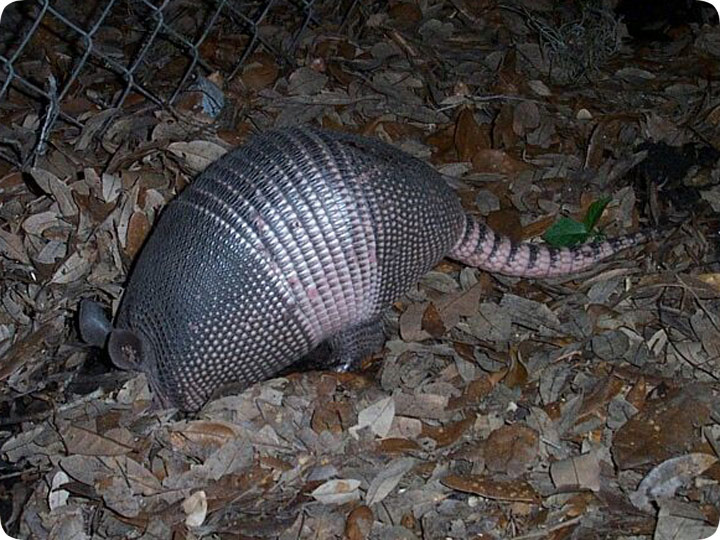-
info@aaanimalcontrol.com
Call us for help in your town
Humane Wildlife Education
Invasive Nine Banded Armadillo in Florida

06.27.2003 - The Nine Banded Armadillo, Dasypus novemcinctus is not native to North America, including the two states in which it most thrives,
Florida and Texas. The mammal is originally from south/central America. However, it has been transplanted to the states, and it survives just fine here. Rumor
has it that the species was introduced to Florida in the early 20th century when two armadillos escaped from a small zoo. Who knows. Usually, exotic, or non-
native species end up establishing populations in suitable habitats, because people
inevitably transport the animals. In the case of the Nine-Banded Armadillo,
Florida turns out to be an ideal environment - there's plenty of food, it's warm enough, the soft soil is easy to dig, and there are no significant natural
predators. Even though armadillos are non-indigenous, I don't think they're harmful at all. They don't breed quickly, they don't spread disease, they don't kill
any existing animals, they don't really compete much for territory with existing animals, they don't destroy crops, and so on. The primary nuisance actually
seems to be in the suburban environment, when they dig tunnels under homes or other manmade structures.
I took the above photo of an armadillo digging in the dirt, in search of earthworms or grubs. Armadillos are alert at times, but at other times, I can sneak
right up and photograph them. They're so busy rooting around for food that they ignore their surroundings. No big deal, if in trouble, their tough hides will
save them from attack.
Do it yourself: Visit my How To Get Rid of Armadillos page for tips and advice.
Get professional help: Visit my Nationwide Pro Directory of wildlife removal experts.
When Do Florida Armadillos Give Birth? The birth cycle of the armadillo is one of the strangest to be found in nature, and with the one embryo splitting off to give every female armadillo four babies, it is easy to predict how many animals will be born. As well as being quite strange in the way that these babies develop, it is also interesting that the female will actually hold the fertilized egg for quite some time before allowing it to develop. This is to help ensure that the baby armadillos are born at the right time of year to give them the best chance of success when they are born.
The breeding season for armadillos will usually take place between June and July, and their gestation period is usually around four and a half months. The interesting thing about being able to delay the growth of the babies is that it allows the female to give birth in the spring, usually in March and April, giving her babies the best chance of survival. When the four children are born, their shells aren?t as solid as an adult?s shell, which means that they will often be with the mother for quite some time before they begin their own individual lives.
For more wildlife stories, click my Wildlife Blog
or click my below banner to hire a local trapper.
Did you know that there are different types of armadillos in the wild? The most widespread of the critters is the nine-banded armadillo, also known as a long-nosed armadillo. This armadillo originated from South and Central America but thrives most in Texas and Florida as an invasive species. Nine-banded armadillos reportedly found their way to Florida in the early 1900s after two of the critters escaped a zoo.
Florida has turned out to be a perfect environment for the nine-banded armadillo due to its environmental conditions that favor the growth and reproduction of the armadillos. Other factors include plenty of food, soft soils that armadillo can dig through with ease, and protection by the state.
What does a nine-banded armadillo look like?
The nine-banded armadillo is one of the largest armadillo species around. An adult species measures approximately 25 to 43 inches long from head to tail and about 10 inches tall. Their bodies are covered by tough skin to protect them from possible dangers and predators. Unlike the three-banded armadillos, the nine-banded species are not capable of rolling their bodies into balls. However, they can float across rivers or sink and run on the river bed.
General Behavior
The nine-banded armadillo behaves almost the same as other species of armadillos. You may not spot any distinct or unique behavior from them. They are solitary critters that forage after sunset. They also burrow in the ground. It is not strange to find up to 12 burrows that have been dug by one armadillo. The nine-banded species marks its territory using feces, urine, and excretion from the scent gland. The males aggressively protect their habitat range. As such, armadillo may chase and fight any intruder armadillo. Perhaps that's why you may see armadillos fighting and chasing after each other.
Breeding
Florida armadillos mate between July and August every year. The critter's birth cycle is unique and begins during the mating season. After mating, only a single egg is fertilized. However, implantation may occur 3-4 months after fertilization to ensure that the young ones are born during favorable times. After fertilization, one embryo is split into four to give the mother four babies. The gestation period is approximately 4.5 months. The four children are born without the shell fully formed. Mother armadillos will have to take care of their babies until they are ready to begin their own lives away from her.




















